
SS Great Britain is a museum ship and former passenger steamship, which was advanced for her time. She was the longest passenger ship in the world from 1845 to 1854. She was designed by Isambard Kingdom Brunel (1806–1859), for the Great Western Steamship Company's transatlantic service between Bristol and New York City. While other ships had been built of iron or equipped with a screw propeller, Great Britain was the first to combine these features in a large ocean-going ship. She was the first iron steamer to cross the Atlantic Ocean, which she did in 1845, in the time of 14 days.

A paddle steamer is a steamship or steamboat powered by a steam engine that drives paddle wheels to propel the craft through the water. In antiquity, paddle wheelers followed the development of poles, oars and sails, where the first uses were wheelers driven by animals or humans.
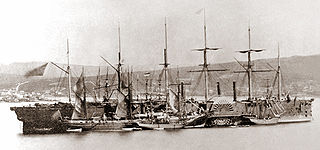
SS Great Eastern was an iron sail-powered, paddle wheel and screw-propelled steamship designed by Isambard Kingdom Brunel, and built by John Scott Russell & Co. at Millwall Iron Works on the River Thames, London. She was by far the largest ship ever built at the time of her 1858 launch, and had the capacity to carry 4,000 passengers from England to Australia without refuelling. Her length of 692 feet (211 m) was only surpassed in 1899 by the 705-foot (215 m) 17,274-gross-ton RMS Oceanic, her gross tonnage of 18,915 was only surpassed in 1901 by the 701-foot (214 m) 21,035-gross-ton RMS Celtic, and her 4,000-passenger capacity was surpassed in 1913 by the 4,234-passenger SS Imperator. The ship's five funnels were rare and were later reduced to four. The vessel also had the largest set of paddle wheels.

Aaron Manby was a landmark vessel in the science of shipbuilding as the first iron steamship to go to sea. She was built by Aaron Manby (1776–1850) at the Horseley Ironworks. She made the voyage to Paris in June 1822 under Captain Charles Napier, with Aaron's son Charles on board as engineer. Aaron Manby was then used by the Compagnie des bateaux a vapeur en fer to operate its service between Paris and Le Havre.
William Fairbairn and Sons, was an engineering works in Manchester, England.
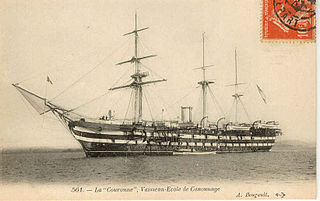
The French ironclad Couronne ("Crown") was the first iron-hulled ironclad warship built for the French Navy in 1859–62. She was the first such ship to be laid down, although the British armoured frigate HMS Warrior was completed first. The ship participated in the Franco-Prussian War of 1870–71, but saw no combat. She was served as a gunnery training ship from 1885 to 1908 before she was hulked the following year and became a barracks ship in Toulon. Couronne was scrapped in 1934, over 70 years after she was completed.
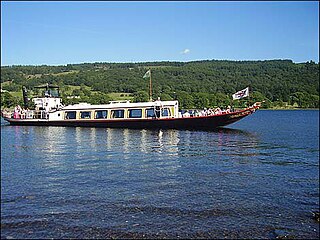
The steam yacht Gondola is a rebuilt Victorian, screw-propelled, steam-powered passenger vessel on Coniston Water, England. Originally launched in 1859, she was built for the steamer service carrying passengers from the Furness Railway and from the Coniston Railway. She was in commercial service until 1936 when she was retired, being converted to a houseboat in 1946. In 1979, by now derelict, she was given a new hull, engine, boiler and most of the superstructure. She is back in service as a passenger boat, still powered by steam and now operated by the National Trust.

The Zürichsee-Schifffahrtsgesellschaft or Lake Zürich Navigation Company is a public Swiss company operating passenger ships and boats on Lake Zürich.

The Swiss Northeastern Railway was an early railway company in Switzerland. It also operated shipping on Lake Constance (Bodensee) and Lake Zürich. Until the merger of the Western Swiss Railways into the Jura–Simplon Railway (JS) in 1890/91, it was the largest Swiss railway company.

The Rhein class of ironclad riverine monitors (Flußkanonenboote) were a pair of ships built by the German Imperial Navy in the aftermath of the Franco-Prussian War. The class comprised two ships, Rhein and Mosel; both were built by the AG Weser shipyard in Bremen, in 1872–1874. They were armed with a pair of 12 cm (4.7 in) bronze cannon in a revolving gun turret. The ships were intended to protect the German border with France in the event of a conflict, but had short service lives, as war did not come. They served briefly in the defenses of Coblenz, starting in 1875, before being withdrawn from service. The two ships were sold for scrap, apparently in December 1884.

SMS Hansa was a German ironclad warship built in 1868–1875. She was the first ironclad built in Germany; all previous German ironclads had been built in foreign shipyards. She was named after the Hanseatic League, known in Germany simply as Hanse, Latinized Hansa. The ship was launched in October 1872 and commissioned into the German Imperial Navy in May 1875. Designed for overseas service, Hansa was classed as an armored corvette and armed with eight 21 cm (8.3 in) guns in a central battery.
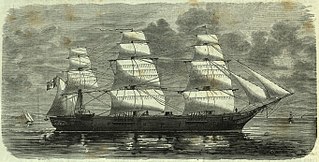
Vettor Pisani was a screw corvette of the Italian Regia Marina built in the late 1860s and early 1870s. The ship left Italy in 1882 for a three-year voyage round the world.

SMS Custoza was an ironclad warship built for the Austro-Hungarian Navy in the 1870s, the only member of her class. She was the first Austro-Hungarian ironclad to be built after the navy studied the results of the Battle of Lissa of 1866; she was also the first iron-hulled capital ship to be built for the Austro-Hungarian Navy. She was laid down in November 1869, launched in August 1872, and completed in February 1875. Her career was fairly limited, in part due to reduced naval budgets in the 1870s that also delayed her completion. Custoza was somewhat more active in the 1880s, taking part in an international naval demonstration against the Ottoman Empire in 1880, being modernized in 1882, and a trip to Spain for the Barcelona Universal Exposition in 1888. The ship became a training ship in 1902, was converted into a barracks ship in 1914, and after World War I, was awarded as a war prize to Italy. Custoza was immediately broken up.

The Stadt Zürich was a Swiss steamship, built in 1855, that plied Lake Constance. She was given the nickname Teufelsschiff because she was involved in three serious collisions with other craft and was said to have sunk more German ships than the Danish navy during the Second Schleswig War.

The Leipzig class was a group of two steam corvettes built for the German Kaiserliche Marine in the 1870s. The two ships of the class were Leipzig and Prinz Adalbert; Prinz Adalbert was originally named Sedan after the Battle of Sedan, but was renamed shortly after entering service to avoid angering France. They were based on the earlier corvette Freya, but were significantly larger, carried a stronger armament, and unlike the wooden-hulled Ariadne-class corvettes, adopted iron construction, making them the first corvettes of the German fleet to be built with iron. Originally intended to serve abroad and with the fleet, British experiences during the Battle of Pacocha in 1877 convinced the German naval command that unarmored warships were useless against the fleets of ironclads being built by the European navies, and so Leipzig and Prinz Adalbert would be used only on foreign stations.

SMS Preussischer Adler was a paddle steamer originally built in the mid-1840s for use on a packet route between the Kingdom of Prussia and the Russian Empire in the Baltic Sea. She was requisitioned by the Prussian Navy during the First Schleswig War in 1848 and converted into an aviso, the first vessel of the type commissioned by Prussia. During the war, she took part in an inconclusive action with the Danish brig St. Croix, the first naval battle of the Prussian fleet. After the war, she was disarmed and returned to her commercial role, operating uneventfully on the Stettin–St. Petersburg route until 1862, when the expansion of the Prussian Eastern Railway had rendered the maritime route superfluous. The ship was purchased by the Prussian Navy that year and rearmed, once again as an aviso.

The Nix class was a pair of avisos built for the Prussian Navy in the early 1850s. The class comprised two ships: SMS Nix and Salamander. They were ordered as part of a modest program to strengthen the fleet at the urging of Prince Adalbert of Prussia in the immediate aftermath of the First Schleswig War, which had demonstrated that the weak fleet could not challenge the ability of Denmark to impose a blockade of Prussian and German ports. They were small vessels with a shallow draft, since they were intended to operate close to shore to defend Prussia's coast. Neither vessel saw significant service in the Prussian Navy before being sold to the British Royal Navy in exchange for the frigate Thetis in 1855. They were renamed Weser and Recruit, respectively, and the former saw action during the Crimean War in the Black Sea later in 1855. The two ships saw little activity after their sale to Britain, with Recruit being laid up in 1861 and Weser following in 1865. Recruit was sold for merchant service in 1870, while Weser was discarded in 1873.

SMS Loreley was an aviso of the Prussian Navy built in the late 1850s. Built as a paddle steamer, since the Prussian naval command was not convinced of the reliability of screw propellers, she was the first Prussian warship to be fitted with a domestically-produced marine steam engine. The ship carried a light armament of two 12-pound guns and had a top speed of 10.5 knots. Loreley was intended to serve as the flagship of the gunboat flotillas that formed the bulk of the Prussian fleet in the 1850s.
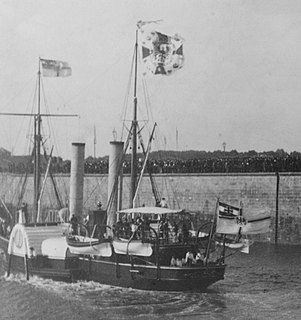
SMS Pommerania was a paddle steamer originally built for use as a packet ship but was acquired by the North German Federal Navy in 1870 during the Franco-Prussian War. Commissioned too late to see service during the conflict, she was initially used to conduct fishery surveys that were later used as the basis for the German Fisheries Act in 1874. Pommerania went to the Mediterranean Sea in 1876 in response to the murder of a German diplomat and remained in the region to observe the Russo-Turkish War of 1877–1878. After returning to Germany in 1879, she spent much of the 1880s either operating as a fishery protection vessel or conducting surveys of the German coastline. Decommissioned in 1889, she was struck from the naval register in 1890, sold in 1892, and was converted into a sailing schooner. She was renamed Adler, but was lost with all hands on her first voyage as a merchant ship in January 1894.

Fijenoord was a shipbuilding and machine factory in Rotterdam the Netherlands from 1823 to 1929. In 1929 it merged with Wilton to become Wilton-Fijenoord.



















